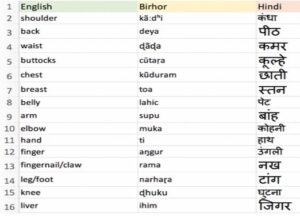“Indigenous languages are a treasure trove of knowledge about a regions’ flora, fauna, and medicinal plants.”- opined Ayesha Kidwai associated with the center of Linguistics, New Delhi.
Origination of the term:
The term Birhor was originated from the Mundari language where it has been regarded as a compound of two important words- ‘Bir’ means forest while ‘Hor’ means the man. Hence, the term as a whole refers to the men of the forest. As per the Census, Birhor is one of the eight primitive tribes residing in the states of Giridih, Hazaribagh, Ranchi, Dhanbad, and Jharkhand (Mohanty, 2020). It has also been found that the total population of this tribal community is only seven thousand and fourteen. Therefore, it is undoubtedly going under the extinction threat. Belonging to the Austro Asiatic language sect, it does not possess any script but is performed verbally. UNESCO has declared the Birhor language among the endangered languages in India. Whereas, it is quite common to other two languages such as Mundari and Santali when it comes to its vocabulary (Mohanty, 2020). One may find it difficult to distinguish Birhor from other native languages like Santhali, Mundari, and Ho languages. Again, the language represents a subject-object-verb order. And using such language, some important works have been conducted by a number of creators. SC Roy’s The Birhor: A little Known jungle tribe of Chota Nagpur and A. K Adhikary’s the Birhor are regarded as some significant works in Birhor.

Figure: A glimpse of Birhor language
(Source: Jora, 2020)
Why the language is endangered?
The language is an indigenous language used in Chattisgarh, West Bengal, and Jharkhand of India but nowadays it is considered a critically endangered language due to its decreasing number of speakers. Indeed, the situation is alarming because only 2000 speakers are left in India who speak Birhor. Preserving tribal languages indeed is important to preserve the culture and heritage of the country. And such culture passes from generation to generation. While if such language declines, the knowledge chain will also lose its way. In this concern, the Jharkhand government has taken minute steps to preserve the existence of Birhor. The scheme for the protection and preservation of endangered languages has attempted to document the language and make a digital trilingual dictionary. Reportedly, ethnolinguistic analysis of the language is in headway. However, the programs are not benefitting the states in preserving indigenous languages (Parish, 2020). In this regard, the state government decided to incorporate several tribal languages in the school curriculum which is a great initiative and may help in the preservation.
Significance of preservation:
Apart from Birhor, there are a number of languages in India that are under extinction threat and are dissolving soon. Thus, the concern of the day must be the preservation of the indigenous languages as it aids in knowing more about the medicinal substances and a lot about the nature that is unleashed to the date. Due to the unavailability of essential resources, several tribal communities have shifted to another community and adopted other languages which threats the origin of indigenous languages and the culture associated with them. However, critics may argue that speaking a single language would benefit society and there is no need to preserve tribal languages. India is indeed a multicultural society along with a plethora of tribal communities. Thus preserving such languages and communities is necessary.
References
Mohanty, A. (2020, August 26). Seven decades after independence, many tribal languages in India face extinction threat. Retrieved from Down to Earth: https://www.downtoearth.org.in/blog/governance/seven-decades-after-independence-many-tribal-languages-in-india-face-extinction-threat-73071
Parish, P. (2020, December). Tribal Language Preservation Strengthens Communities But Needs Consistent Funding. Retrieved from Montana Budget and Policy Center: https://montanabudget.org/report/tribal_languages_2020